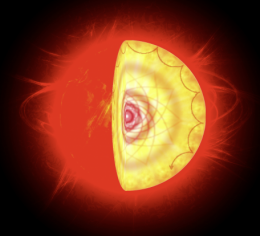Astronomers detect echoes from the depth of a red giant star

(PhysOrg.com) -- Today an international team of astronomers reports the discovery of waves inside a star that travel so deep that they reach the core. The discovery was published in the renowned journal Science, and was possible thanks to precise measurements with the Kepler space telescope.
Waves traversing stars, similar to sound waves here on Earth, were already known to exist, but up to now only waves in the outer part of the star were observed. They travel hundred thousands of kilometers deep, and at a certain depth the stellar material gets too dense to penetrate so that the waves bounce back to the surface. The team now unexpectedly found the signature of waves that run all the way to the center of the star.
Astronomers love this kind of waves, or stellar oscillations as they call them. Just like a doctor listens to the sound of your heart to make a diagnosis, or like seismologists use earthquakes on Earth to probe the inside of our planet, the scientific discipline of asteroseismology studies stellar oscillations to draw a detailed picture of stellar interiors. The detection of waves that are able to “sense” the conditions in the core of a star opens a window to an inferno which otherwise would remain unreachable and hidden.
The discovery was made in a red giant star. These are elderly stars which our Sun will become in about 5 billion years. By that time our Sun will have inflated more than 10 times its current size, and will be about 50 times brighter. At the same time its color will have changed from yellowish to reddish, hence their name.
“Having a view into the core of these red giants will teach us exactly what will happen to our Sun when it grows older.”, says Paul Beck, a PhD student at Leuven University in Belgium. Paul is one of the many young researchers that are given the opportunity to work with Kepler data. He, Tim Bedding of The University of Sydney, and Marc-Antoine Dupret from the University of Liège were the first to notice that some oscillations seemed to behave differently, “out of key”. After comparing the observations with theoretical models, they soon realized that they were looking at waves that feel the conditions in the heart of the star.
At the starʼs surface the oscillations manifest themselves as patches where the temperature changes slightly, more or less periodically over time. Overall, this causes tiny variations in the brightness the star, and after the light traveled for hundreds of years through empty space these changes are now carefully recorded by NASAʼs space telescope Kepler.
The team that made the discovery is part of KASC, the Kepler Asteroseismic Science Consortium, currently one of the largest consortia in astronomy, consisting of more than 440 astronomers specialized in probing stellar interiors. Its headquarters are located in Aarhus, Denmark. “Astronomers of all over the world are taking part in this huge effort to exploit Kepler data to better understand the interiors of stars”, says Hans Kjeldsen of Aarhus university, the coordinator of KASC. “The measurements provided by Kepler are so incredibly precise that we see things we never saw before. Itʼs like traveling in a whole new world.”
The spacecraft is expected to operate for at least another 2 years, and will continue to measure the same stars, making the datasets better every day. For sure to be continued.
More information: Kepler-Detected Gravity-Mode Period Spacings in a Red Giant Star, Science, DOI:10.1126/science.1201939
Provided by Leuven university


















